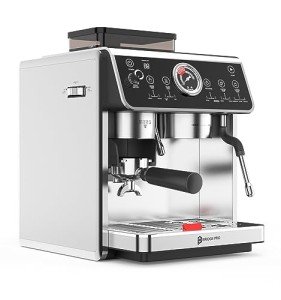Heat Exchange Espresso Machines: A Comprehensive Guide
Espresso machines have actually evolved significantly for many years, accommodating the requirements of home baristas and coffee specialists alike. Among these machines, heat exchange espresso machines have actually acquired popularity due to their capability to provide constant performance and remarkable brew quality. In this post, we will explore the functions, advantages, and essential functions of heat exchange espresso machines, offering a thorough understanding for both possible purchasers and coffee enthusiasts.
Comprehending Heat Exchange Technology
Heat exchange espresso machines run on a distinct concept that allows synchronised water heating for developing and steaming. They are geared up with a single boiler that utilizes a heat exchanger system. This feature is substantial as it enables users to brew espresso while steaming milk concurrently, promoting effectiveness in the coffee-making procedure.
How Does a Heat Exchange Espresso Machine Work?
The process starts with the machine's water inlet filling the boiler. As Latte Machines heats up, it turns to steam. The ingenious heat exchanger utilizes hot steam to heat extra water in a separate passage developed particularly for the brew group. This implies that water can reach the perfect developing temperature level without waiting on the boiler to change. The crucial actions include:
- Water Fill: Water is drawn into the boiler.
- Heating Process: The boiler heats up as water is transformed into steam.
- Heat Exchange: Steam warms water in the heat exchanger tube.
- Developing: Water from the heat exchanger is pushed through coffee grounds, drawing out the tastes needed for a rich espresso.
This procedure permits quick temperature level modifications and improved coffee extraction.
Benefits of Heat Exchange Espresso Machines
Heat exchange espresso machines offer several benefits, especially for those aiming to maximize their coffee experience. Here are some essential advantages:
- Simultaneous Brewing and Steaming: Users can brew espresso while steaming milk, making it ideal for hectic cafes and home baristas who value efficiency.
- Temperature Stability: The boiler's steam pressure assists preserve a stable temperature, which is crucial for consistent espresso extraction.
- Flexibility: The design enables quick changing in between developing and steaming, making it much easier to produce various coffee drinks, from lattes to coffees.
- User-friendly: Models frequently come with accessible controls, making it possible for both newbies and knowledgeable baristas to produce quality drinks.
- Professional Quality: Heat exchange machines are often used in commercial settings, offering users with high-quality brewing efficiency at home.
Key Features to Look for in Heat Exchange Espresso Machines
When thinking about the purchase of a heat exchange espresso machine, there are a number of features that one must take into account:
- Build Quality: Look for machines made of long lasting materials, such as stainless steel or brass, ensuring durability.
- Boiler Size: A larger boiler will hold more water and sustain higher output gradually.
- PID Temperature Control: This function assists keep consistent brew temperatures, which can boost the coffee-making process.
- Group Head Design: Machines with a saturated or semi-saturated group head supply better temperature stability.
- Alleviate of Use: User-friendly user interfaces and intuitive controls enhance the overall experience for baristas at all skill levels.
- Steam Wand Quality: A good steam wand with appropriate insulation and flexibility enables much better texturing of milk.
- Water Reservoir Size: Depending on your needs, consider how typically you desire to fill up the water reservoir.
Comparison of Popular Heat Exchange Espresso Machines
To much better understand the choices offered in the market, below is a contrast table of some popular heat exchange espresso machines:
| Machine Model | Boiler Size | PID Control | Cost Range | User Ratings |
|---|---|---|---|---|
| Profitec Pro 700 | 2.0 L | Yes | ₤ 2,000-₤ 2,500 | 9.5/ 10 |
| Rocket Espresso R58 | 1.8 L | Yes | ₤ 2,400-₤ 2,800 | 9.4/ 10 |
| Elekta Bianca | 1.8 L | Yes | ₤ 2,500-₤ 3,000 | 9.6/ 10 |
| La Spaziale S1 Vivaldi II | 1.5 L | Yes | ₤ 1,800-₤ 2,200 | 9.2/ 10 |
| Bezzera Magica | 1.2 L | No | ₤ 1,600-₤ 1,800 | 9.0/ 10 |
FAQs About Heat Exchange Espresso Machines
What is the main difference between a heat exchange and a dual boiler espresso machine?
While both types can brew espresso and steam milk at the exact same time, dual boiler machines have different boilers for developing and steaming. On the other hand, heat exchange machines use a single boiler and a heat exchanger to attain the very same function.
Are heat exchange machines appropriate for beginners?
Yes! Latte Machines are developed with easy to use functions, making them accessible for beginners. With appropriate assistance and practice, users can quickly produce quality espresso.
What type of upkeep do heat exchange espresso machines require?
Regular upkeep includes descaling, cleaning up the boiler, inspecting seals and gaskets, and keeping the group head clean. Routine upkeep makes sure longevity and constant efficiency.
Can I use a heat exchange machine for various types of coffee beverages?
Absolutely! Heat exchange machines allow users to create a variety of coffee beverages, consisting of espresso, lattes, coffees, and more.
Heat exchange espresso machines represent a mix of innovation and tradition, supplying coffee lovers with the tools needed for crafting the perfect cup. Their capability to simultaneously brew and steam, combined with precise temperature control, makes them an engaging choice for both home baristas and experts. With the right knowledge on functions and upkeep, users can open a world of charming coffee experiences, making sure that each sip is as wonderful as the last.

